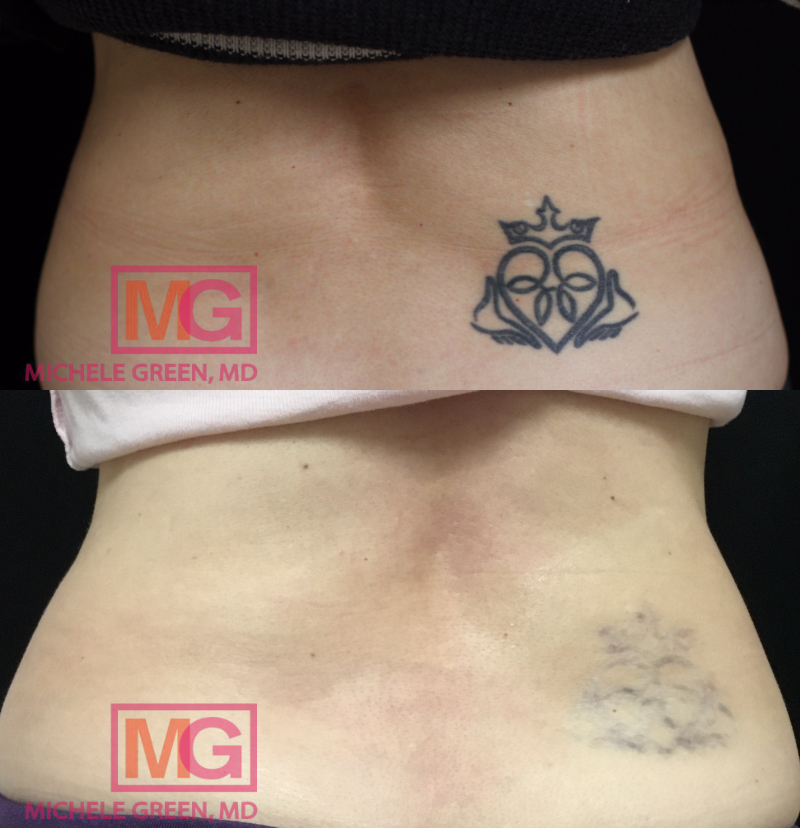Laser Tattoo Removal
Laser tattoo removal is considered the safest and most effective method for removing unwanted tattoos. Laser treatments work by targeting the pigment in tattoo ink while leaving the surrounding skin unaffected. There is minimal downtime and few potential side effects, making laser tattoo removal an easy and accessible treatment option for people who no longer love their tattoos. At her private dermatology office in NYC, Dr. Green offers the gold standard, the AlexTriVantage laser, for laser tattoo removal. The AlexTriVantage is safe and effective for patients of all skin types and tones, including darker skin, which may be more susceptible to unwanted side effects with other laser treatments.
The laser tattoo removal process is straightforward, and a treatment session can be completed in 5-30 minutes, depending on the size of the tattoo. During laser tattoo removal, the tattoo pigment absorbs the laser energy, and the ink shatters into smaller particles. The broken-down ink particles are then small enough for the immune system to remove them from the body, resulting in a lightening effect in the treated area and a visibly diminished tattoo. Different colors of ink absorb different wavelengths of light, which is why different laser lights are needed to treat different tattoo colors. It is important to have laser treatments, including laser tattoo removal, with an expert to ensure safety, efficacy, and optimal results and prevent unwanted side effects like hypopigmentation, hyperpigmentation, and scarring.
Dr. Michele Green in New York City is an internationally renowned expert in the field of cosmetic dermatology with over two and a half decades of experience providing some of the world’s most discerning individuals with the best non-invasive treatment options available, including laser tattoo removal. She utilizes the most cutting-edge laser treatments to get rid of unwanted tattoos of various pigments, inks, and sizes. Dr. Green takes a holistic approach and embraces a less-is-more philosophy regarding skin rejuvenation, customizing each patient’s treatment plan to suit their particular concerns and aesthetic goals best. She is consistently identified as one of NYC’s best dermatologists by Castle Connolly, New York Magazine, Super Doctors, and the New York Times for her dedication to her patients and expertise. When you consult with Dr. Green regarding laser tattoo removal, she will work with you to build a personalized treatment plan.
How does laser tattoo removal work?
Advancements in laser technology have made laser tattoo removal the most effective method for permanently eliminating tattoo pigment without damaging the surrounding skin. Tattoo ink sits in the dermis, below the skin’s surface layers. When a tattoo is first placed, the ink particles are too large to be affected by the immune system, which is why tattoos are permanent. During laser tattoo removal, the tattoo pigment absorbs the laser energy, and the ink shatters into smaller particles. The broken-down ink particles are then small enough for the immune system to remove them from the body, resulting in a lightening effect in the treated area and a visibly diminished tattoo. Different colors of ink absorb different wavelengths of light, which is why different laser lights are needed to treat different tattoo colors. Black tattoos are the easiest to remove because they absorb all wavelengths of laser light.
The number of treatment sessions required can vary depending on the tattoo’s size, color, and the type of tattoo ink that was used for the piece. The patient’s aesthetic goals can also impact the total number of treatment sessions needed. Some patients only have a few laser tattoo removal treatment sessions in order to fade the tattoo enough to get a cover-up. Patients who are interested in the complete removal of an unwanted tattoo will require additional treatment sessions. Laser treatment is safer than many other procedures used to remove tattoos, such as dermabrasion, cryosurgery, salabrasion, and excision, since it only affects the pigment in the tattoo ink and not the surrounding skin.
AlexTriVantage for Laser Tattoo Removal
The most popular and safest laser technology for removing unwanted tattoos is the Q-switched nd:yag laser. The Q-switched laser is a high-intensity pulsed beam that delivers laser light in short bursts. When the laser light penetrates the skin in the treated area, the tattoo pigment absorbs the energy and converts it to heat, which shatters the tattoo ink particles into smaller pieces. The immune system can then remove the smaller ink particles from the body, creating a lightening effect in the treated area. At her private dermatology office in NYC’s Upper East Side neighborhood, Dr. Green uses the Candela AlexTriVantage for laser tattoo removal. The Alex TriVantage® is a unique Q-switched laser/nd-YAG that is gentle and safe for all skin types, including darker skin and Asian skin.
One of the advantages of this laser is that it can remove tattoos with different colors of ink without damaging the surrounding skin. Alex TriVantage removes tattoo ink safely and effectively, with minimal discomfort. Blue and green tattoo inks are known for their stubbornness during laser tattoo removal, but Alex TriVantage can break down even blues and greens. The Alex-TriVantage can be used for laser tattoo removal on all areas of the body, including the face, neck, arms, legs, and back. The same laser technology is also effective at removing pigmented lesions, brown spots, sun spots, and age spots from the face and body. The AlexTriVantage laser treatment is also effective in reducing the appearance of other types of unwanted pigmentation, including sun spots, freckles, and birthmarks.
Laser Tattoo Removal Procedure with Dr. Michele Green in NYC
The first step is scheduling a consultation with Dr. Green at her private dermatology office in Manhattan’s Upper East Side neighborhood. During your consultation, Dr. Green will collect a thorough family and medical history, physically evaluate the unwanted tattoo, and review any previous cosmetic procedures you may have had. She will then make recommendations regarding the cosmetic treatment options best suited to your skin type, tone, and the type of tattoo you have. If you are a good candidate for laser tattoo removal, the procedure may be performed on the same day or scheduled for a later date, depending on time allowance and preference.
Depending on the size and location of the tattoo, a topical or local anesthetic is used to numb the area before the procedure. If numbing cream is used, it should be applied to the tattoo one hour before the laser treatment to ensure there’s sufficient time to allow it to act. Once the area is cleaned and sterilized with alcohol, Dr. Green uses the AlexTriVantage to deliver high-intensity laser light to the tattoo pigment. The laser tattoo removal process typically takes five to thirty minutes, depending on the size of the tattoo. Afterward, an antibiotic ointment and bandage will be applied to the treated area to promote the healing process and protect the skin while it is sensitive.
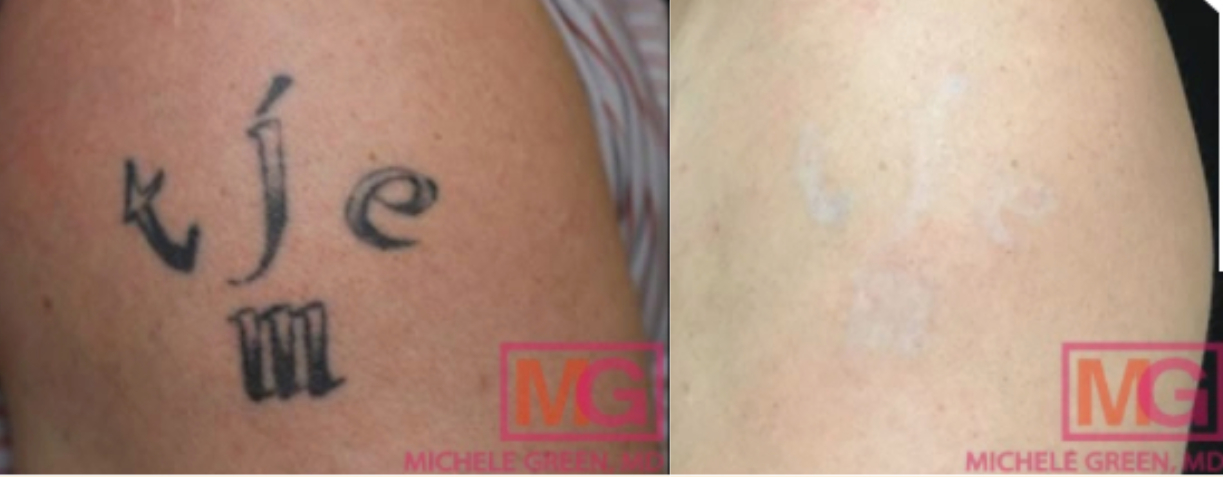
AlexTrivantage laser for tattoo removal, 8 treatments
How long does laser tattoo removal take?
Laser tattoo removal is a straightforward process that is usually quicker and easier than getting the tattoo itself. Depending on the size of the tattoo, a laser tattoo removal treatment session can take anywhere from five to thirty minutes. Other factors that might influence how long your laser tattoo removal treatment session takes can include the type of laser being used to remove the unwanted tattoo and the age, depth, and color of the tattoo. If multiple tattoos are being removed within one treatment session, more time will be required. While each laser treatment session does not typically require a significant amount of time, complete removal of an unwanted tattoo does require multiple treatment sessions, each spaced 6-8 weeks apart. Dr. Green will reassess your unwanted tattoo during each follow-up treatment session to ensure that you’re making progress toward a visibly clearer complexion.
What are the side effects of laser tattoo removal treatment?
Modern laser technology has made the tattoo removal process safer and easier than ever before. Nevertheless, some common side effects that can develop in the treated area include blistering, scabbing, peeling, redness, bruising, and tenderness. These side effects usually resolve on their own within a week of laser tattoo removal treatment. It is important to keep the treated area covered with an antibiotic ointment or cream in the initial days following the laser treatment to promote the healing process and prevent skin infection. Adhering to the aftercare instructions provided to you by Dr. Green will be important for achieving optimal results. While much less common, another potential side effect can be hypopigmentation in the treated area. Hypopigmentation occurs when the laser removes pigment from tattoo ink and skin cells, creating patches of skin that are lighter than the surrounding skin. Mild cases of hypopigmentation may resolve on their own, while more severe cases are likely to be permanent. Long-lasting discoloration of the skin following laser tattoo removal is generally very rare, but it occurs more commonly in darker skin. Although rare, there have been reports of paradoxical darkening of cosmetic tattoos, especially with pink, tan, or white-colored tattoos. The likelihood of encountering severe hypopigmentation and other unwanted side effects, such as hyperpigmentation and scarring, is significantly reduced when an expert, such as board-certified dermatologist Dr. Green in NYC, performs laser tattoo removal.
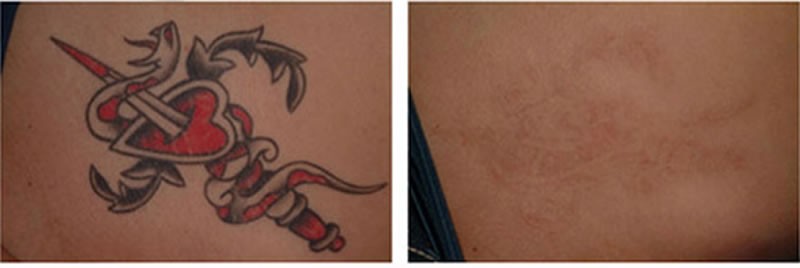
How long after laser treatment will the tattoo fade?
The laser tattoo removal process requires time. Usually, multiple treatment sessions are required to achieve the desired results, with each treatment session spaced 6-8 weeks apart. Laser tattoo removal treatment can not achieve complete removal in a single treatment session because the tattoo pigment is broken down layer by layer. The immune system removes the treated ink particles by filtration through the liver. With each treatment session, there will be a gradual lightening in the tattoo pigment. The tattoo should progressively become lighter each week as the white blood cells continue to carry away the ink from the tattoo. Results may be seen around the third treatment session, although they vary for each individual. Because laser tattoo removal also depends on your immune system, the overall health of your immune system can play a major role in how fast the body can eliminate the ink particles broken down by the laser light. When you have laser tattoo removal treatments with Dr. Green in NYC, she will reassess the progress of your tattoo lightening during each follow-up treatment session.
How many laser treatment sessions are needed?
The number of treatment sessions required to achieve the complete removal of an unwanted tattoo will ultimately depend on a variety of contributing factors, including the age, depth, will depend on the type of tattoo ink, the tattoo colors, age, and depth, and the patient’s skin type. Since there are so many variations in the chemical compositions of tattoo ink and a wide range of tattoo colors used by tattoo artists, it can be impossible to predict exactly how many laser treatment sessions will be needed for the complete removal of an unwanted tattoo. Usually, small tattoos that are done with black ink are the easiest to remove, while older, multi-colored tattoos are more difficult. Furthermore, the depth of the ink deposited into the skin varies in amateur tattoos, ranging from the epidermis (the outermost layer of the skin) to the dermis (the deeper layer of the skin). In professional tattoos, the ink is uniformly deposited into the dermis. It can take six to twelve treatments to remove some multi-colored tattoos. Laser tattoo removal is a gradual process, as the laser light shatters the tattoo ink layer by layer. Unwanted side effects, including severe hypopigmentation, hyperpigmentation, and scarring, are more likely to develop with aggressive laser treatment.
When you consult with internationally renowned board-certified dermatologist Dr. Michele Green in NYC, she will collect a thorough medical history, physically assess the unwanted tattoo, and review any previous cosmetic treatments you may have had. She will work with you to develop a personalized plan for laser tattoo removal and establish a timeline for your treatment sessions to suit your needs best. Dr. Green will evaluate your progress during each follow-up treatment session to ensure you’re reaching your goal of complete removal of your unwanted tattoo.
What to expect after laser tattoo removal
One of the greatest advantages of laser tattoo removal over other tattoo removal methods is that it is completely non-invasive and directly targets the tattoo ink while leaving the surrounding skin unaffected. Due to the nature of the laser technology used for removing an unwanted tattoo, there is very minimal discomfort and downtime and few potential side effects following the procedure. Some patients may experience mild, common side effects, including redness, swelling, bruising, blistering, and scabbing in the treated area. Still, these side effects tend to subside on their own within a week, should they occur. Keeping the area covered with antibiotic ointment and a bandage for the first few days after each laser treatment session will help promote healing and prevent skin irritation or damage. It is also important to avoid sun exposure in the treated area since laser treatment increases the skin’s photosensitivity, making it more susceptible to UV damage.
After each subsequent treatment session, common side effects should diminish in severity. Directly following a laser tattoo removal treatment session, patients can resume most of their regular daily activities. However, strenuous exercise, baths, hot tubs, swimming pools, and saunas should be avoided for several days to prevent exacerbating any side effects and allow the skin to heal properly. When you have laser tattoo removal treatments with Dr. Green at her private dermatology office in NYC’s Upper East Side neighborhood, she will provide you with all of the relevant aftercare instructions required for achieving and maintaining ideal results.
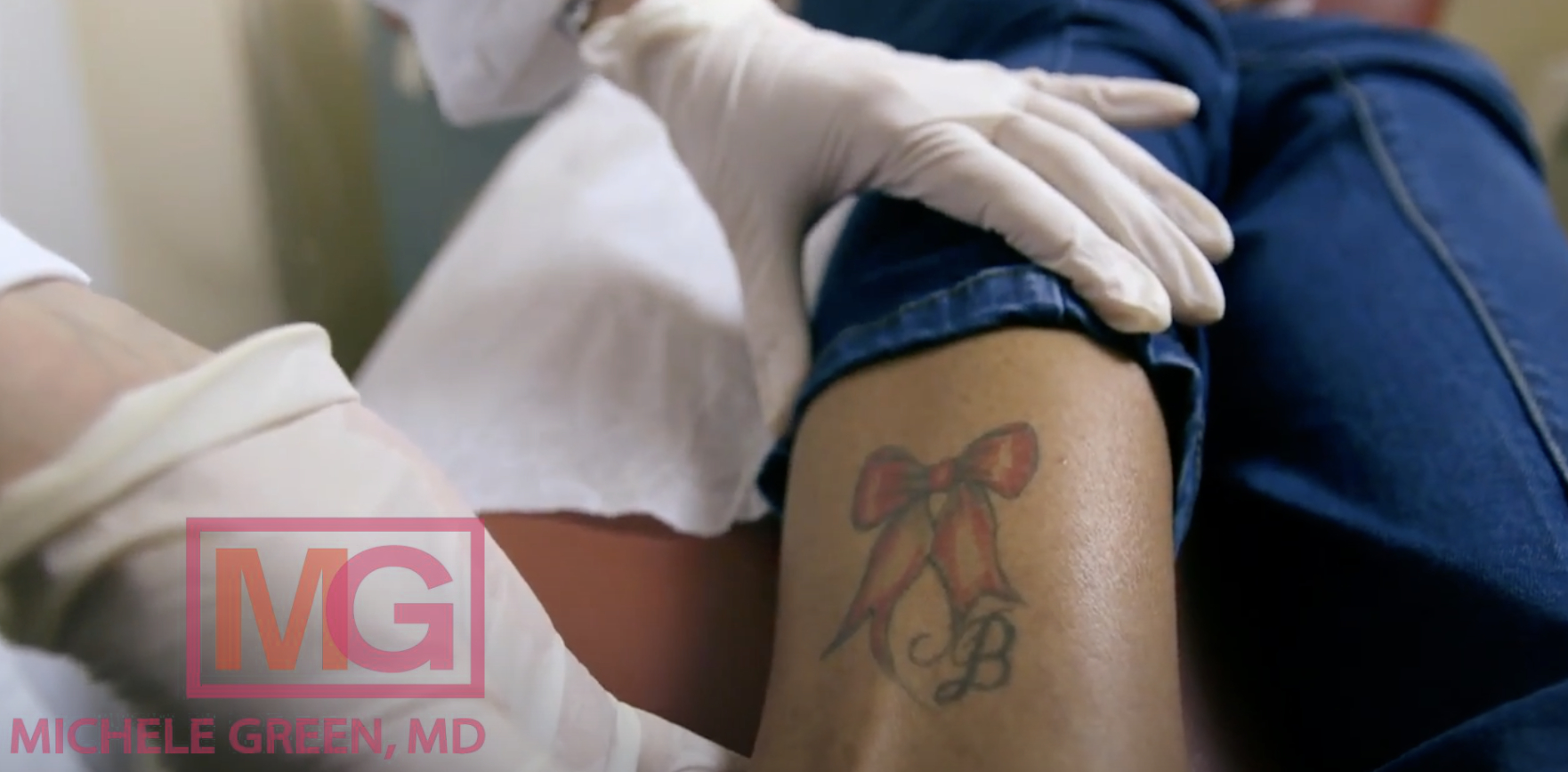
FAQs about Laser Tattoo Removal
How much does laser tattoo removal cost?
The cost of laser tattoo removal can depend on several factors, including the size of the tattoo, the type of laser selected for treatment, the experience level of the healthcare provider you’re being treated by, and your geographic location. Other factors that may influence the total cost of your laser tattoo removal treatment include the location of the tattoo, the tattoo colors, and the age of the tattoo. If multiple tattoos are being removed or additional treatment sessions are required for complete removal, there will be additional costs. Since laser tattoo removal is considered to be a cosmetic procedure and non-medically necessary by insurance companies, they typically are not covered under health insurance benefits. The price of laser tattoo removal for small tattoos is less than that of larger tattoos. On average, each laser tattoo removal treatment session costs around $600.
Tattoo removal may be more inexpensive with a provider who is not a healthcare professional, such as in a medical spa setting. However, when someone other than a healthcare professional performs laser tattoo removal, the likelihood of encountering dangerous or unwanted side effects increases. It is recommended to have laser tattoo removal with an experienced board-certified dermatologist, such as Dr. Michele Green, in New York City to avoid hypopigmentation, hyperpigmentation, and scarring in the treated area and ensure the best final results. Dr. Green has over two and a half decades of experience providing some of the world’s most discerning individuals with the best non-invasive treatment options, including laser tattoo removal. When you consult with Dr. Green, she will work with you to estimate the total cost of your laser tattoo removal and develop a plan that meets your needs, goals, and budget.
Is laser tattoo removal safe?
Yes! Thanks to modern laser technology, removing an unwanted tattoo is safer and easier than ever before. Various clinical studies have been undertaken to prove the safety and efficacy of laser tattoo removal treatments in patients of various skin types and tones. The laser device used by Dr. Green at her private dermatology office in NYC for tattoo removal, the AlexTriVantage, has been approved by the U.S. Food and Drug Administration (FDA). FDA approval means that laser tattoo removal was tested in many clinical studies and deemed safe and effective for tattoo removal. To guarantee safety, efficacy, and optimal results and to prevent unwanted side effects, laser treatments should always be performed by a trained and experienced healthcare professional, such as board-certified dermatologist Dr. Michele Green in NYC. An institution such as a medical spa may offer free consultations and specials for subscribers. However, seeking laser treatment from a MedSpa or similar institution can increase your risk of developing serious side effects, including hypopigmentation, hyperpigmentation, and scarring. An experienced, board-certified dermatologist like Dr. Green will be able to adjust the laser treatment settings to ensure that it is appropriate for your skin type, tone, and the type of tattoo you would like to remove.
Can you get laser tattoo removal while pregnant?
Individuals who are pregnant or breastfeeding are advised to avoid having laser tattoo removal treatments. Pregnant and breastfeeding individuals should not have laser tattoo removal due to the fact that the effects of laser tattoo removal treatment have not been evaluated on pregnant and breastfeeding women. With the lack of data surrounding the effects of laser treatment on the fetus or baby, those who are pregnant or breastfeeding are advised to wait to have the procedure. If you are currently pregnant or breastfeeding and interested in removing an unwanted tattoo, you can still schedule a consultation with Dr. Michele Green regarding a future treatment plan. Dr. Green will collect a thorough medical and family history, physically assess the unwanted tattoo, and review any previous treatments you may have had to develop a plan that’s appropriate for your needs and goals.
Does laser tattoo removal cause cancer?
No. The Skin Cancer Foundation has concluded that laser tattoo removal does not cause skin cancer. There have been some studies warning that tattoos with red ink may cause cancer. Laser tattoo removal treatment does, however, increase the skin’s photosensitivity. More photosensitive skin is more susceptible to damage from the sun’s UV rays, meaning that avoiding sun exposure in the treated area is very important. In addition to limiting sun exposure, Dr. Green advises her patients to wear sun-protective clothing over the treated area and to use sunscreen. Dr. Green typically recommends layering two different types of sunscreen to ensure maximum coverage and protection. First, a chemical sunscreen should be applied, followed by a mineral sunscreen. Chemical sunscreen protects the skin from UV rays by absorbing them, converting them into heat via a chemical reaction, and releasing them from the body. Common active ingredients in chemical sunscreen include avobenzone, oxybenzone, and octinoxate. Mineral sunscreen contains active ingredients like zinc oxide or titanium dioxide and works by acting as a barrier and blocking UV rays from penetrating the skin. Sunscreen should always be labeled as broad-spectrum, indicating that it offers protection against UVA and UVB rays, and it should have a minimum SPF of 30. Patients with fairer skin or a history of skin cancer should use sunscreen with a higher SPF.
Does laser tattoo removal cause nerve damage?
No. Laser tattoo removal does not cause nerve damage. The laser light only penetrates the layers of skin where the tattoo ink is to shatter the pigment into smaller particles so that they can be processed out of the body by the immune system. The laser energy does not penetrate the skin deep enough to affect nerves. Other underlying structures, including muscles, tendons, ligaments, and bones, will also remain unaffected by laser tattoo removal. Professional musicians and others who rely on their hands for work sometimes express concerns about the effects of laser tattoo removal on their fine motor skills. However, when laser tattoo removal treatment is performed by an expert like board-certified dermatologist Dr. Michele Green in NYC, the procedure is safe, and patients can resume most of their daily activities afterward.
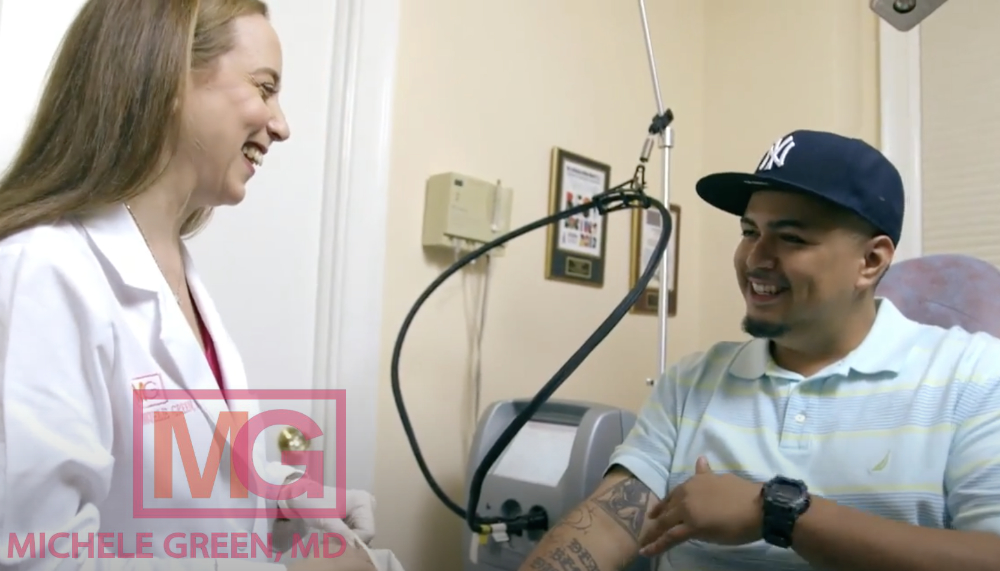
Does tattoo removal damage skin?
No. One of the advantages of laser tattoo removal compared to other tattoo removal methods is that it only affects the tattoo ink while leaving the surrounding skin unharmed. Generally, side effects of laser tattoo removal are mild and resolve within a week after a given treatment session. These mild side effects include redness, swelling, bruising, scabbing, peeling, and blistering. It is crucial to refrain from picking at the treated area if blistering, peeling, or scabbing occurs. Aggravating the treated area further if these side effects are present can result in increased inflammation and potentially lead to scarring or hyperpigmentation. Unwanted side effects, including permanent scarring, hyperpigmentation, and hypopigmentation, are also much more likely to occur when an inexperienced or unqualified provider does laser tattoo removal treatments. It is always recommended to have laser tattoo removal with an expert, such as board-certified dermatologist Dr. Michele Green in NYC, to prevent permanent skin damage. Dr. Green is an internationally renowned board-certified dermatologist with over 25 years of experience providing some of the world’s most discerning individuals with the best non-invasive cosmetic procedures, including laser tattoo removal, and will work with you to ensure you get the best results.
Does laser tattoo removal hurt? Is it painful to have a tattoo removed?
Many patients compare the sensation of having laser tattoo removal to a rubber band snapping against the skin. Some describe laser tattoo removal as comparable to the feeling of getting a tattoo. Dr. Green prescribes her patients a topical anesthetic that should be applied in a thick layer to the entire area that is going to be treated one hour before the scheduled appointment time. If the tattoo being treated is on an area of the body that may be covered by clothing, a piece of plastic wrap can be applied over the numbing cream to keep it from getting on your clothes. Once you arrive at Dr. Green’s NYC dermatology office, the numbing cream will be removed, and the skin will be sterilized with alcohol in preparation for the laser treatment. An individual’s personal pain tolerance and the location of the unwanted tattoo can influence the amount of discomfort one feels during the laser treatment, but the numbing cream helps significantly. There may be some soreness, blistering, scabbing, or peeling in the treated area in the first few days following the laser treatment while the skin heals. Dr. Green recommends taking Tylenol as needed to soothe any discomfort in the days following laser tattoo removal treatment.
Is the skin sore after tattoo removal?
The skin in the treated area may be sore following tattoo removal, depending on the type of removal used, the location of the unwanted tattoo, and the patient’s general pain tolerance level. If there is any soreness in the treated area, Dr. Green advises taking Tylenol as needed for relief. Side effects from a laser tattoo removal treatment, including any tenderness or soreness in the treated area, tend to resolve within a week of the procedure.
Can I shower after laser tattoo removal?
For the first three days following laser tattoo removal, the treated area should remain bandaged and kept dry. It is okay to take a shower after having laser treatment for an unwanted tattoo so long as the treated area stays dry. After three days, the bandage can be removed, and the treated area can be cleaned in the shower. Dr. Green advises taking some precautions to protect the treated area while it’s sensitive and to promote the best healing process following the procedure. The treated area should not be soaked or fully submerged in water but can be washed with a gentle cleanser. After cleansing, it should be pat dry in order to avoid irritating the skin in the treated area. Baths, hot tubs, and swimming pools should be avoided throughout the laser tattoo removal process. When you have laser tattoo removal with Dr. Green at her private dermatology office in NYC’s Upper East Side neighborhood, she will provide you with all of the pertinent aftercare information required to achieve the best final results.
Can I exercise after laser tattoo removal?
Strenuous exercise should be avoided for at least 48 hours following a laser tattoo removal treatment session. The treated area may be inflamed or sore in the first couple of days, and exercising can exacerbate inflammation or worsen other side effects like blistering and peeling. When you have laser tattoo removal with Dr. Green at her boutique dermatology office in NYC’s Upper East Side neighborhood, she will give you all of the aftercare instructions you need to get the best treatment outcome.
Does laser tattoo removal remove hair?
Laser tattoo removal usually doesn’t result in hair removal or otherwise affect hair growth. The laser light does not affect the hair follicles, although some wavelengths of light may affect the pigment in darker hairs and result in their temporary removal. If hair removal is the patient’s primary concern, Dr. Green has multiple types of lasers to achieve optimal results.
Laser Tattoo removal – before and after 8 sessions
Will laser tattoo removal leave a scar?
When you have laser tattoo removal with an expert, such as internationally renowned board-certified dermatologist Dr. Michele Green in NYC, the result is simply a visibly clearer complexion. It is important to have laser tattoo removal treatment with an experienced board-certified dermatologist like Dr. Green, who has the expertise required to select the appropriate type of laser and settings for your skin type, tone, and the type of tattoo you have. When an inexperienced or unqualified provider performs laser tattoo removal, the risk of encountering dangerous and unwanted side effects, including hypopigmentation, hyperpigmentation, and scarring, increases. Dr. Green has over two and a half decades of experience in the field of cosmetic dermatology and will ensure that you get the results you’re seeking.
The risk of scarring in the treated area also increases if it is not cared for properly following the laser treatment. In the first several days after the laser treatment, the treated area should be covered with antibiotic ointment and a bandage to promote healing and protect the skin from irritation. Avoid excessively rubbing or touching the skin in the treated area to allow the skin to heal. After a shower or a bath, gently pat the area dry with a towel instead of rubbing it. It is important to keep the treated area clean because the site is more susceptible to infection. Avoid picking at the scabs that form because that will cause trauma to the skin and prevent healing. Protecting the treated site from sun exposure is also important to avoid scarring since laser treatment increases the skin’s susceptibility to UV damage. Inform Dr. Green if you have a history of abnormal scarring or keloids before undergoing laser tattoo removal treatment.
Can you tattoo over laser tattoo removal?
Yes! Tattoos can be placed over an area that has been treated with laser tattoo removal. Instead of trying to achieve complete removal, some patients undergo just enough laser tattoo removal treatment sessions to fade the tattoo to the point that a cover-up tattoo can be done. The skin must finish healing before another tattoo is placed in the treated area. Dr. Green recommends waiting for at least six weeks after your last laser tattoo removal treatment before booking an appointment for a new tattoo. It is important to give time for the area to heal and for your immune system to settle before getting a new tattoo in order to protect the new ink in the treatment area and have the best results. It is best to inform your tattoo artist about your recent laser tattoo removal treatment, and they can also make a recommendation on the ideal timeline for getting another tattoo.
What does laser tattoo removal feel like?
Most patients describe the feeling of having laser tattoo removal as though rubber bands are snapping against the skin in the treated area, often followed by a feeling of warmth. Some patients think that laser tattoo removal treatment feels similar to getting a tattoo. While there may be some discomfort during the laser tattoo removal process, it is temporary and tolerable. Dr. Green prescribes all of her patients a topical anesthetic that should be applied one hour before the laser treatment to minimize discomfort. Once you arrive at Dr. Green’s boutique NYC dermatology office, the numbing cream will be removed and the skin sterilized in preparation for treatment. For any tenderness or soreness in the treated area following the laser treatment, Dr. Green recommends taking Tylenol.
What does laser tattoo removal look like?
Immediately following a laser tattoo removal treatment session, there may be a “frosting” effect that gives the skin a chalky appearance. Temporary skin lightening is a safe and normal part of the laser tattoo removal process, and it occurs because the heat from the laser light causes carbon dioxide to be released from the skin. This lightening is an expected skin reaction that generally lasts only a few minutes and up to half an hour. Afterward, the treated area may develop common side effects like redness and swelling, which usually resolve within a few hours of the laser treatment. Other side effects can include itching, blistering, scabbing, tenderness, or peeling in the treated area. These are signs of the skin’s natural healing processes and typically last up to two weeks. It is important to keep the treated area covered with antibiotic ointment and to refrain from picking at any blistering or scabbing to make sure the skin heals best following laser tattoo removal.
The healing process can be elongated if the treated site is scratched or the blisters are formed. Scratching and picking causes trauma to the skin, delaying the skin from healing completely, which can also increase the risk of infection or permanent scarring. For the best results, refrain from picking at scabbing, blistering, or peeling. Laser tattoo removal makes your skin photosensitive, which means it is very important to limit sun exposure to the treated area. Wear protective clothing over the treated areas and apply sunscreen with an SPF 50 on the treatment sites in between sessions to prevent hyperpigmentation. Be sure to reapply the sunscreen every 90 minutes if you are exposed to the sun for a prolonged time and have the treatment area covered.
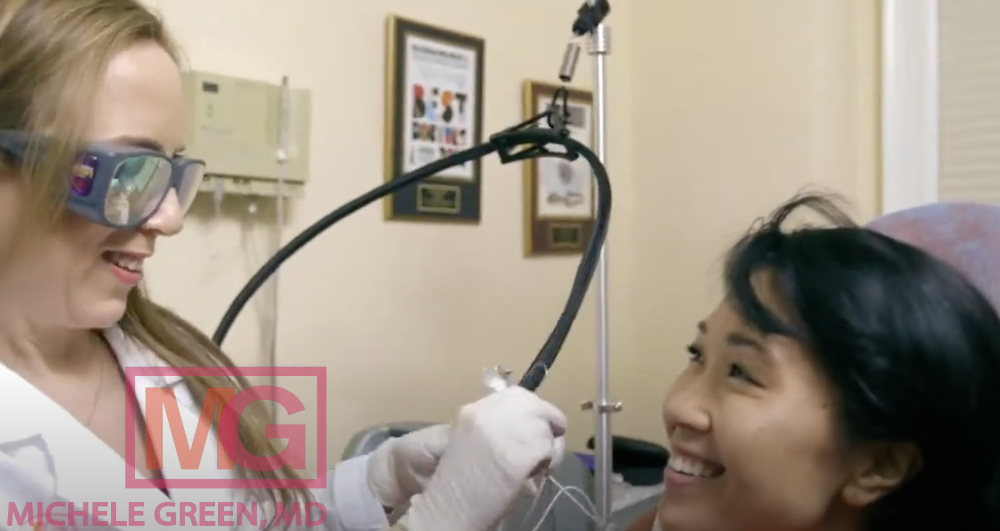
How well does laser tattoo removal work? How effective is laser tattoo removal?
Modern laser technology used for tattoo removal is considered one of the most effective and safest treatment methods for removing unwanted tattoos, and they are relatively painless and have a quick recovery time. A benefit of laser tattoo removal is that it will not affect the surrounding skin and will only target specific tattoo ink pigments. Today’s laser technology allows for the complete removal of the tattoo, regardless of tattoo color and skin type, with fewer treatments, relatively short downtime, and minimal discomfort. The results of laser tattoo removal and how many sessions are needed depend on a variety of factors, including the size of the tattoo, age, color, depth of the tattoo, and the amount of ink, as well as the general skin condition and type. When you consult with Dr. Green regarding laser tattoo removal, she will collect a thorough medical and family history, physically assess the unwanted tattoo or tattoos, and review any previous cosmetic procedures you may have had to ensure that laser tattoo removal will be effective for your needs and goals.
Can laser treatment completely remove a tattoo?
The advanced laser technology today allows for complete removal, including tattoos of various colors. Darker-colored tattoos can easily be removed completely through laser tattoo removals. Black and blue ink tend to respond well to laser treatment due to their ability to absorb a wide range of wavelengths of light. In previous years, laser treatments were not able to effectively remove colored ink, which was hard to remove. The challenge in removing colored ink was based on the fact that laser tattoo removal was similar to laser hair removal, in which the laser only detected dark colors like black. With the technological advancements in lasers, this is not an accurate statement anymore. Lasers like Alex TriVantage can target all different colors of tattoo ink. It is important to note that not all tattoos can be removed completely because tattoo ink is comprised of a variety of organic and inorganic ingredients that the provider is unable to detect prior to treatment.
How to get started with laser tattoo removal in NYC today
An unwanted tattoo can be a great annoyance and, for many, may even cause feelings of self-consciousness. If you have an unwanted tattoo that no longer reflects who you are, has a negative association that you’d like to forget, or is no longer cosmetically appealing, laser tattoo removal may be the solution for you. Additionally, many tattoo artists will ask that you have an old tattoo faded with laser tattoo removal before they do a cover-up tattoo. The type of laser used for your laser tattoo removal must be appropriate for your skin type and skin tone in order to avoid unwanted or dangerous side effects. It is always recommended to consult with an expert board-certified dermatologist, like Dr. Green, in New York City, to develop a safe and effective treatment plan for diminishing the appearance of your unwanted tattoo.
Dr. Michele Green is an internationally renowned board-certified dermatologist with over two and a half decades of experience providing some of the world’s most discerning individuals with the best non-invasive cosmetic treatment options available, including laser treatments for removing unwanted tattoos. She is consistently identified as one of NYC’s best dermatologists by Castle Connolly, New York Magazine, the New York Times, and Super Doctors for her dedication to her expertise. Utilizing the most cutting-edge laser technology and innovative treatment techniques, Dr. Green has helped countless individuals to look and feel like the best version of themselves. To get started with removing an unwanted tattoo with laser treatment, schedule a consultation with Dr. Green by contacting us online or calling the NYC-based office at 212-535-3088.
 212-535-3088
212-535-3088 